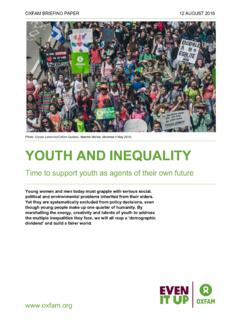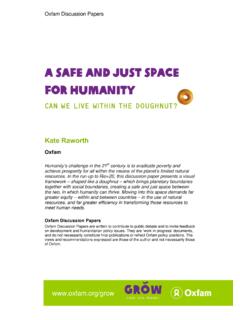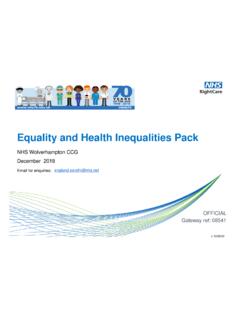Transcription of The true cost of austerity and inequality: UK case study
1 OXFAM CASE study SEPTEMBER 2013 THE TRUE COST OF austerity AND INEQUALITY UK Case study Pre-crisis UK The UK is the sixth richest country in the From 1993 to 2008 it saw 15 years of economic growth, underpinned by the socio-economic reforms of the 1980s. This shift towards market-based capitalism was characterized by financial liberalization, the erosion of social security and deregulation of the labour market. However, these reforms have led to a dramatic increase in the number of people living in poverty, which almost doubled, from million people in 1979 to million in 2008,2 and inequality reached levels last seen in the 1920s,3 driven by a growing share of income going to the richest, in particular the top one per cent.
2 Since 1975, income inequality among working-age people has risen faster in the UK than in any other OECD nation, including the United States,4 such that the UK now ranks as one of the most unequal countries in the Indeed, the UK has a pre-tax income inequality index of , greater than the United States ( ).6 The average annual income in the UK for the top 10 per cent of the population in 2008 was roughly 55,000; for the bottom 10 per cent, it was just 4,700 a ratio of 12:1. This is up from a ratio of 8:1 in 1985, and significantly higher than the average income gap in developed nations of 9 The crisis The 2008 financial crisis led the UK government to bail out British banks at an estimated cost of 141bn, with exposure to liabilities of over 1 This unprecedented state intervention was undertaken to prevent a collapse of the British banking system.
3 At the same time, the government began a 31bn stimulus effort, which included reducing VAT, bringing forward capital spending on schools and social housing, and 2 deferring an increase in corporation tax. The stimulus programme lasted until 2010; during that time, incomes grew fastest for the poorest fifth of the population (at per cent) and slowest for the richest two-fifths (at per cent).9 austerity measures Since 2010, austerity primarily in the form of deep spending cuts with comparatively small increases in tax10 has been the UK government s dominant fiscal policy, with far fewer measures to stimulate the economy.
4 The stated aim of austerity was to reduce the deficit in the UK to give confidence to the markets and therefore deliver growth to the economy. While austerity measures have had some impact on reducing the deficit, they have delivered little growth, and public debt has risen from per cent of GDP in July 200911 to 90 per cent of GDP ( trillion) in The policies have also had far-reaching impacts on the poorest people in the UK. In 2010, the Conservative-Liberal Democrat coalition government announced the biggest cuts to state spending since the Second World War,13 including significant cuts to social security and the planned loss of 900,000 public sector jobs between 2011 and Since the 2008 financial crisis began, those already in poverty have seen their impoverishment worsen, and millions more have become more vulnerable.
5 Because they kept giving me days off, I couldn t afford to keep the job. I was left with nothing. If it was a full-time job, I wouldn t have had to leave it, you see. By the time I paid transport, paid rent and everything, I was left with nothing. I was losing out on money Lee, Glyncoch, Wales Economic stagnation, the rising cost of living, cuts to social security and public services , falling incomes, and rising unemployment have combined to create a deeply damaging situation in which millions are struggling to make ends Just one example among many is the unprecedented rise in the need for emergency food aid, with at least half a million people using food banks each As a result of the tax and welfare changes to be implemented between 2010 and 2014.
6 The poorest two-tenths of the population will have seen greater cuts to their net income, in percentage terms, than every other group, except the very richest The Institute for Fiscal Studies found that the net direct effect of the coalition government s tax and benefit changes will be to increase both absolute and relative Over the decade to 2020, an additional 800,000 children are expected to be living in poverty almost one in four British Over the same period, an extra million working-age adults are expected to fall into poverty, bringing the total to per cent of this group.
7 When incomes are adjusted to account for inflation, absolute poverty has already seen its largest year-on-year increase in a decade, rising by 900,000 in 3 This is happening at a time when levels of unemployment remain stubbornly high. Despite reaching a 40-year low of per cent in 2004,21 the unemployment rate was has remained above 7 per cent since 2009. In 2012, unemployment reached per cent, a level last seen in In the year to May 2009, the number of people who were unemployed rose by 760,000 (from million to million) and, as of August 2013, stood at million ( per cent).
8 23 Of even greater concern has been the growth of youth unemployment24 and long-term unemployment,25 which have remained at historically high levels since the financial crisis began. Unemployed people will experience a loss of income close to 7 per The decision to change how social security payments increase will have a particularly damaging effect; linking payments to a lower inflation index, the Consumer Price Index (currently per cent), instead of the Retail Price Index ( per cent) means incomes will not rise to match increases in the cost of These changes will affect the poorest hardest, as basic costs for food,28 energy29 and housing30 have outpaced inflation over the last few years.
9 This impact is compounded the poverty premium31 and recent measures to limit increases of some social security payments including Jobseeker s Allowance, Housing Benefit and Child Benefit to just 1 per cent annually for the next three years, which greatly affects those in in-work For those in work, average hourly wages have fallen in real terms by per cent since There has also been a considerable shift in the type of jobs created, with half of the increase in employment numbers since 2010 being in temporary work and a doubling of people involuntarily in temporary In other words, people who want permanent jobs are increasingly unable to find them.
10 The number of people taking part-time work because they are unable to find full time work has more than doubled since In addition, self-employment, which can leave workers with no employment rights, has seen a dramatic increase, particularly since Women have arguably been worst affected by the crisis: of the in net personal tax increases and benefit cuts, an estimated (72 per cent) will impact upon women. Women will also suffer to a greater degree from cuts to public services , due to their comparatively higher representation in the public sector. Since the 2008 financial crisis, female unemployment has risen from 678,00037 to million in 201338 a level last seen in 198839.







